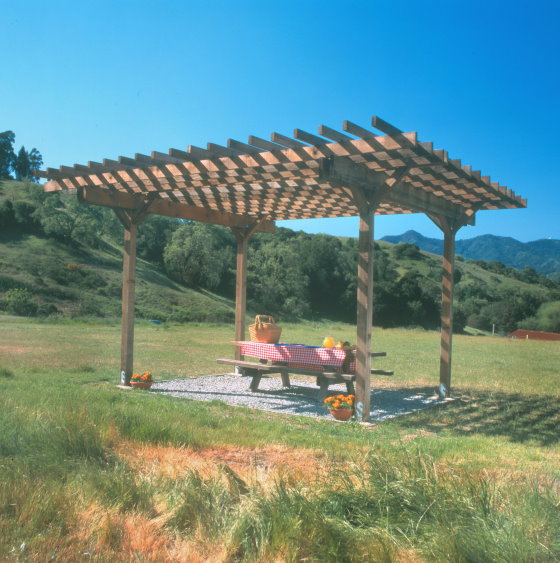Building a Trellis or Arbor

Building a trellis or arbor for your yard is a great way to get introduced to some basic construction techniques and principles. Even the most basic trellis or shade structure involves columns (posts), beams, rafters, ledger boards, etc. Some of these terms may seem foreign to you. Don't worry or be intimidated! A small lightweight trellis can be built in as little as two hours. Even if it collapses, I doubt that it would do more than cause a minor scratch or bruise. In other words, relax!
Work with Components
If you have ever built a trellis or a shade structure you know that when completed they are somewhat flimsy. Knowing this, imagine how hard it would be to keep several posts straight and firm while you are banging nails into them! The structure will shake and wobble the entire time.
I have found it is much easier to build the side panels and the "roof" as separate components. You can build these on a garage floor or workbench. With a helper, you can actually attach the pieces together on level ground with removable bolts. Once you are satisfied that it is going to work, you can transport it to the spot in your yard already assembled. Set it right next to where it will be installed so that you can get the spacing and locations of the post holes right the first time.
Assembly Hardware
If you decide to spend the time to create a beautiful trellis or arbor, I urge you to spend the extra $10 - 20 for stain resistant hardware connectors. Nothing will make a trellis or arbor look worse than rusting nails or bolts in 2 - 4 years.
Black stains can also result if you use redwood or cedar as your trellis material. These wood species contain natural chemicals that preserve the wood against rot. However, these chemicals react with iron and water to form an ugly black stain.
You can prevent stains and rust forever by simply using stainless steel nails and bolts. These are readily available in many hardware stores and the big box home centers. You will pay more, but it will be worth it. Don't be fooled by the shiny zinc chromate finish on the regular nuts and bolts. This is a very thin electroplated coating that can wear off in as little as 18 months.
Pretreat for Best Results
Does the paint peel readily on your house? Do you know that most paint failure can be traced to moisture penetration into the wood?
A trellis or an arbor is subjected to the worst possible conditions. It is out in the open with no protection from rain. Water can easily get into the overlapping pieces of wood. This water then enters the wood, creates expansion and elevated vapor pressure. Then end results are usually blisters and peeling.
You can minimize blisters and peeling if you seal the wood material before you start to cut it up to build the trellis sections. If you decide to paint, I would prime the wood first and then apply one finish coat. As you cut and assemble the individual pieces of wood, always apply some paint or sealer to the exposed end grain after the cut is complete. This is where water enters wood with the greatest of ease.
If you decide to use a clear or semi-transparent sealer you must use a synthetic resin water repellent. Quite possible the best product currently available is Defy. You can get it by calling 800-860-6327.
Regular nationally advertised wood sealers and protectants often contain natural oils for the resin. These compounds are FOOD for mildew and algae! That is why your deck turns black and green....... Don't let it happen to your beautiful redwood or cedar trellis. It would be a crime.
What Wood Should I Use?
That is a great question. I intend to use redwood for my trellises. Redwood is easy to work with, is rot resistant, and simply gorgeous. A close second in my opinion is Western Red Cedar. It is a very attractive wood as well. Personally I would never paint these woods. A pigmented coat of Defy is what I intend to use.
You can also use CCA treated pine. However, if you do this, I would not recommend painting your trellis or arbor. Why? Because during the treating process, massive amounts of water is injected into the lumber. If you paint the wood before all of this water escapes from the lumber, you will have massive paint peeling problems within a matter of years. Treated lumber can be painted, but only after it dries out.
The problem with this, is that as it dries in the sun, it often warps, twists, checks, splits, etc.! If you have enormous patience, let it air dry inside your garage for 2 years and then get ready to build. I think you see why I intend to use redwood......
Related Column: Arbor
Column B191